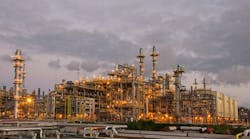Mikaila Adams
Editor-News
A forward-looking view of the financial state of the US energy market, a survey by Haynes and Boone LLP captured optimism by and for the oil and gas industry as participants forecast an increase in available credit and plans predicated on capacity constraints rather than commodity price volatility.
A majority of the 123 respondents surveyed—an industry cross-section of executives at oil and gas producers, oil field services companies, energy lenders, private equity firms, and other industry participants—said they expected borrowing power to increase.
Producers’ loans are assessed by their lenders twice yearly to determine how much credit will be available based on the collateral value of the producers’ property. The borrowing bases turn on banks’ projections about future prices for the producers’ oil and gas reserves. The September poll of Haynes and Boone’s “Borrowing Base Redeterminations Survey”—conducted twice yearly since April 2015—captured predictions about producers’ future borrowing capacity.
When asked specifically about what the likely outcome of the traditional producer-lender meeting to assess borrowing capacity would be, the majority—over 78%—said they expect producers will see borrowing bases increase compared with borrowing bases in spring 2018. Further, 36% of respondents expect borrowing bases to increase by 20% or greater, a rate of optimism on par with the firm’s spring borrowing base survey. In the April survey, more than 80% of respondents said they expected borrowing bases to increase, with most expecting 10-20% increases.
“The survey shows that optimism for the upstream oil and gas industry is really gaining momentum,” said Kraig Grahmann, head of Haynes and Boone’s energy finance practice group.
In general terms, the track record for the surveys has been favorable, with actual numbers closely tracking expectations, and producers’ and bankers’ expectations in close alignment, Buddy Clark, Haynes and Boone energy practice co-chair told OGJ. “In 2015 when prices were much more volatile and industry sentiment was negative, the actual borrowing base redetermination reductions were not as dramatic as the respondents anticipated,” he said.
Shifting concerns
Differing from concerns from years prior, a sudden drop in commodity prices or high costs of oil field services aren’t top-ranked. “Now, when asked about the biggest challenge facing oil and gas industry participants, survey respondents were most concerned about midstream capacity constraints in transporting production to market,” Grahmann said. Forty two percent cited the transportation issue, making it the top concern for producers in 2019 by far. Rising costs of oil field services came in as the second-greatest concern with 19%, while commodity price volatility came in third with 17%. While at the bottom of the list at 6%, a new concern: trade war tensions.
In another parallel to the firm’s spring survey, borrowers are locking in strong oil prices. Two thirds of September’s respondents indicated that borrowers a majority of 2019 production hedged. Public filings of E&P companies indicate this trend started at yearend 2017, held strong through 2018, and looks as though it will continue.
Asked if the hedging activity and midstream capacity constraints were intertwined, Clark recalled the 2015-17 downturn. The years “provided ample evidence to producers that it is prudent to protect against downside,” he told OGJ. “Now that oil prices are above breakeven for all major shale basins, it makes sense to lay in some hedges. We hear from our clients that capacity constraints coming out of the Permian are a problem for 2019 but expectations are that by 2020 with new capacity being built this will not be an issue for long.”
Fall 2018 expectations regarding capital sources were almost identical to spring survey results. Producers continue to favor cash flow from operations, bank debt and private equity as their primary sources of capital.

